A couple have discovered a World War II Nazi bunker marked with eerie Nazi phrases under their home after excavating their entire garden to uncover it.
Shaun Tullier, 35, and his wife Caroline, 32, uncovered the shelter lying 26ft below their house on the island of Guernsey years after moving in in October 2021.
After removing more than 100 tonnes of soil from their front garden, they were eventually met with an eerie staircase leading down into two large rooms and a hallway.
There are even a number of German phrases left on the walls of the base, including one reading ‘achtung feind hort mit’ – which translates to ‘beware, the enemy is listening’.
The couple, from Torteval, have since decided to turn the bunker into their own games room complete with a snooker table and a gym. They are hoping to finish painting it in November, but have decided to keep the creepy writing in tact.
They had been aware the property had been used as a German gun emplacement but they always wondered if there may be more hidden below the surface.
These sorts of wartime structures were left behind after the German forces occupied the Channel Islands from 1940 until 1945 and, under Adolf Hitler’s orders, turned the the islands into an ‘impregnable fortress’.
It was only when Shaun and Caroline began renovating their front garden that the previous owners of the house got in touch and confirmed their suspicions.
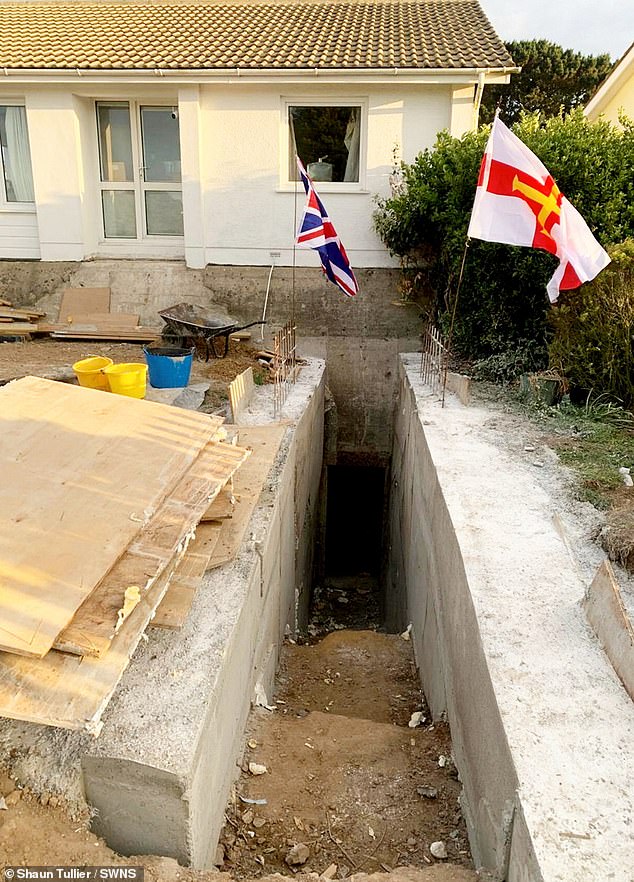
The entrance to the bunker which was discovered by Shaun Tullier and his wife Caroline underneath their front garden this year

Eerie German phrases were left on the walls of the base, including one reading ‘achtung feind hort mit’ – which translates to ‘beware, the enemy is listening’

One phrase inside the bunker reads ‘achtung feind hort mit’ – which translates to ‘beware, the enemy is listening’
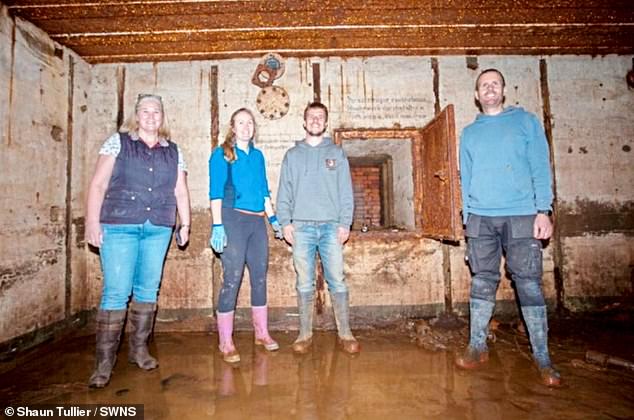
Shaun Tullier, 35, and wife Caroline, 32, (centre) discovered a World War II Nazi bunker under their home in Guernsey
Shaun said: ‘I was born in Guernsey, so I always knew about bunkers, but when Guernsey people came back to Guernsey after the war, they wanted to fill all the bunkers up.
‘A lot of people still have bunkers here, but they are down the road and in gardens – not underneath the house!
‘You just never knew what state these bunkers are in – where they are, how deep they are – you can’t start digging all round just to try and find out.
‘We knew the actual foundation of the house had been utilised as a German gun storage – but what we didn’t know is if there were any rooms.
‘We always thought, ‘imagine that!’ but we had no factual information around it.’
Shaun explained how initially the pair wanted to convert their front garden into a turning point – so they dug it up, and gravelled it over during works.
As Shaun works as a carpenter, he made some chopping boards to sell on Facebook marketplace – when the old owner of the house got in touch with him and gave him a tip off about a wartime building lying underneath the property.
He said: ‘The old owner of the house got in touch with me – as she recognised the very pink kitchen in the photos. She said, oh did you find the rooms below your house!
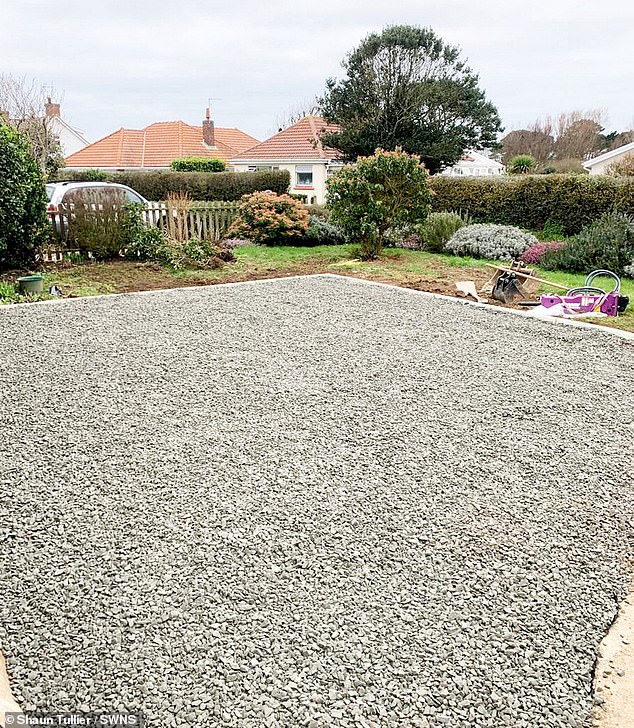
For years the couple’s front garden had gone untouched – until they were told by the previous owner of the house that a WW2 bunker was hidden underneath it
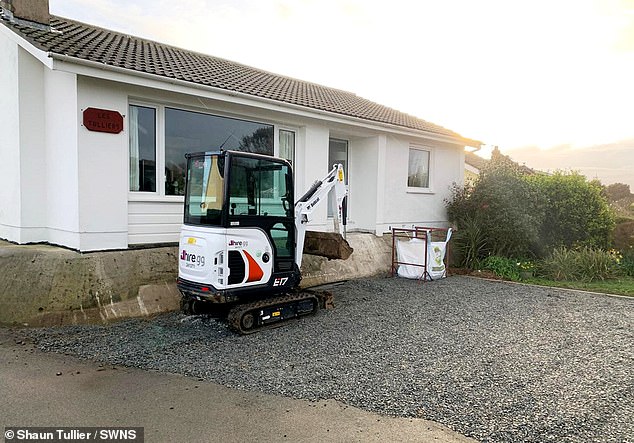
The couple’s driveway is seen here just after being renovated – it was dug up just a week after being completed
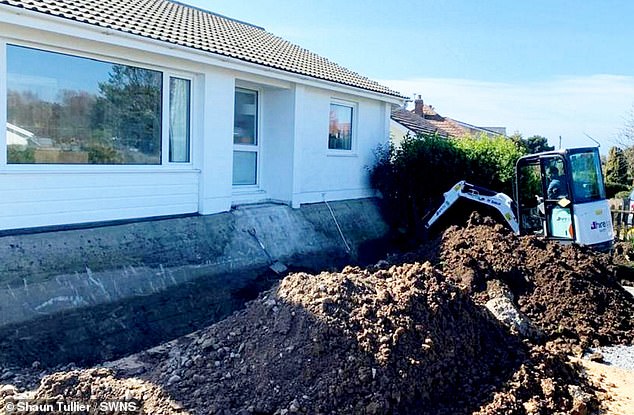
Shaun and Caroline’s friend and digger driver Ryan De Jersey is seen excavating the driveway in the hopes of finding the hidden bunker

The entrance to the bunker can be seen partially obstructed by tonnes of soil during the excavation
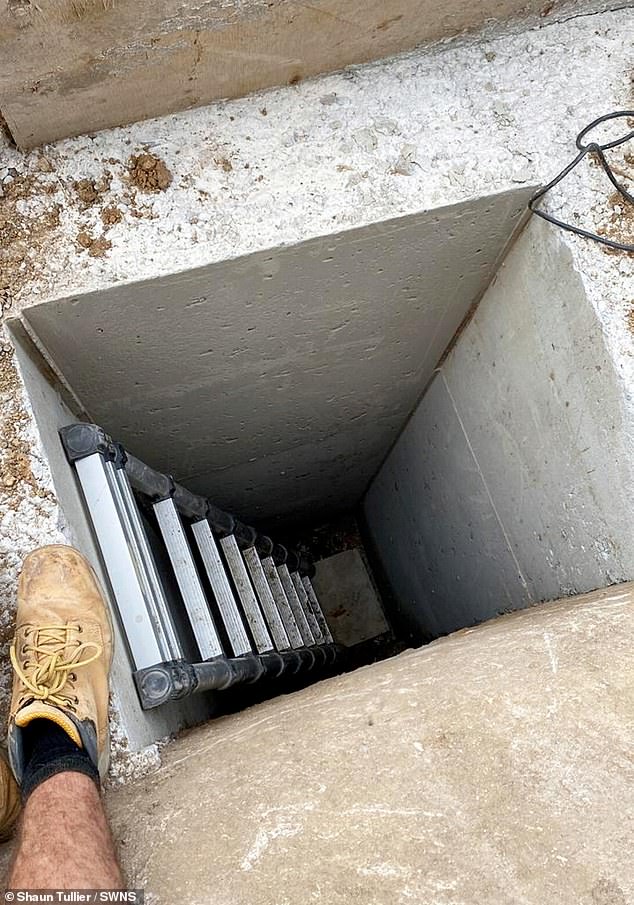
The entrance to the bunker features quite a sharp drop into a pitch black tunnel
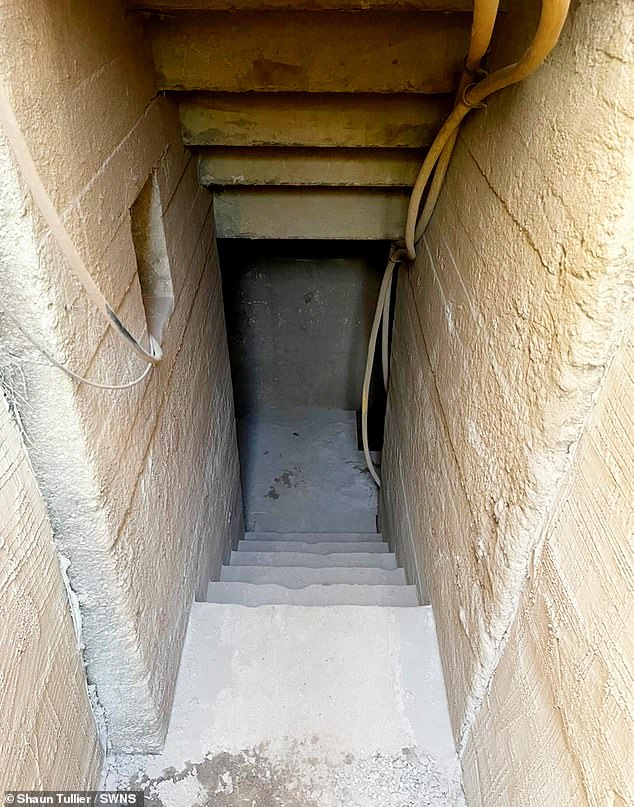
Bunkers like these were left behind after the German forces occupied the Channel Islands from 1940 until 1945
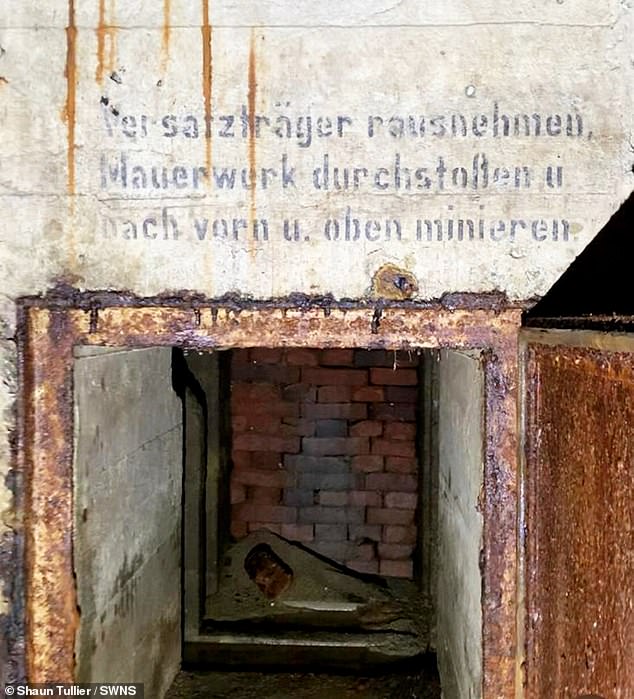
The writing in the tunnel reads: ‘Versatztrager rausnehmen mauerwork durchstollen u bach vorn u oben minieren’ which rougly translates to ‘Remove substitute supports, tunnel through the masonry, and mine the creek in front and above’

The couple have since begun turning the WW2 bunker into a games room

The bunker consists of two main rooms measuring 17ft by 10ft and 17ft by 20ft, and a hallway which is 30ft by four ft wide
‘I then replied, “oh, so there are rooms!”, to which she said, ‘yes, we used to play in there when we were kids, my dad filled it in – I know they’re at the front of the house.
‘It was very interesting – so I then said to my wife, we’re going to have to dig up the drive again – a week after putting it down.
‘I told my friend about the news, and he thought it sounded ace – so replied, if you get the digger, I’ll dig it up!’
They ended up digging up 100 tonne of ground and discovering the entrance to the bunker.
The bunker consisted of two main rooms measuring 17ft by 10ft and 17ft by 20ft, and a hallway which is 30ft by four ft wide.
From ground level to floor level of bunker is 26ft down. Some of the features the family discovered were lots of old bottles, rubble, water, tiled floor, an escape hatch and German writing on the walls.
Shaun said: ‘You can’t really put it into words. It is history and it’s good to have but I couldn’t have imagined going through that – it really puts you back, especially when you go down. It’s cold and damp.
‘The people doing it, they didn’t have a choice. It’s not just rooms for us, it’s a part of history.’
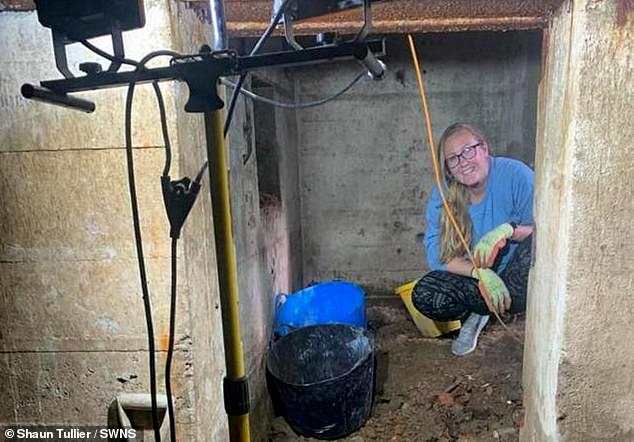
Caroline is pictured inside one of the winding tunnels as they continue work to renovate the bunker
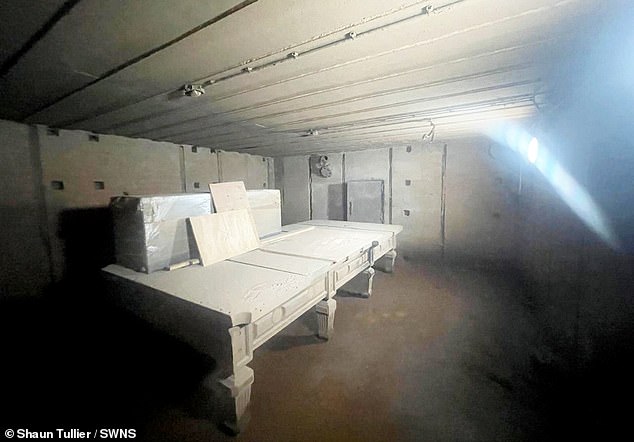
An old table, which appears to be in good nick, sits in one of the rooms
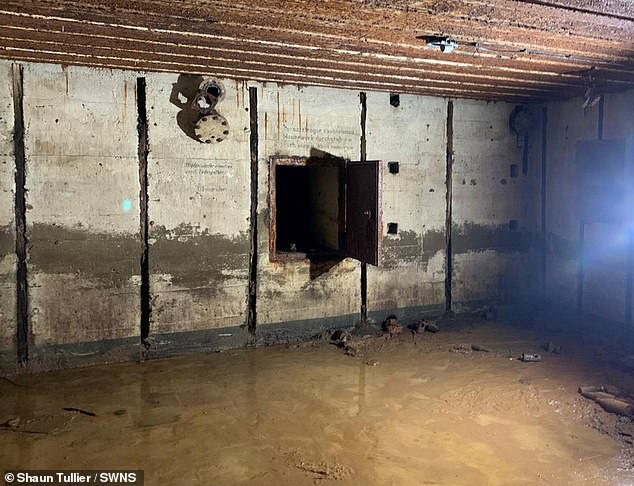
There is also an eerie escape hatch in one of the rooms
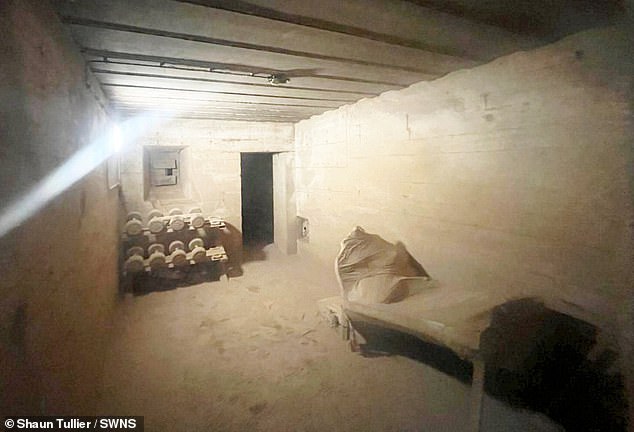
The bunker two large rooms one of which appears to be equipped with old gym equipment
During the work, the family ended up putting 80 tonnes of concrete in for the walls and steps, and they are still converting the bunker into a games room – fitted with a snooker table and a gym.
Shaun added: ‘It’s not something you find everyday! We are definitely keeping the writing – and might get someone that can calligraphy it back on, otherwise it gets lost. Even the air getting to it has faded it a bit.
‘So in that way we can kind of frame it. My wife is not great, she wants the house done – not the bunker!
‘But I have promised everyone a halloween party down there for the last three years, so fingers crossed it’s happening this year – it’s my duty to uphold.’
During the Occupation, hundreds of islanders were deported to prisons in Europe and many who remained on the islands nearly starved.
Guernsey and Jersey were liberated when occupation ended on 9 May 1945.
Sark was liberated a day later, while Alderney, where most of the islanders had been forced to leave their homes, could not return until 15 December 1945.
Islanders now celebrate the end of the German occupation with Liberation Day events in Guernsey, Jersey and Sark, along with Homecoming Day in Alderney.












